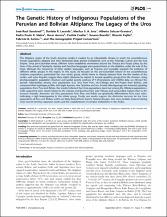Mostrar el registro sencillo del ítem
The Genetic History of Indigenous Populations of the Peruvian and Bolivian Altiplano: The Legacy of the Uros
| dc.contributor.author | Sandoval Sandoval, José Raul | |
| dc.contributor.author | Lacerda, Daniela R. | |
| dc.contributor.author | Jota, Marilza S. | |
| dc.contributor.author | Salazar Granara, Alberto Alcibíades | |
| dc.contributor.author | Vieira, Pedro Paulo R. | |
| dc.contributor.author | Acosta, Óscar | |
| dc.contributor.author | Cuellar, Cinthia | |
| dc.contributor.author | Revollo, Susana | |
| dc.contributor.author | Fujita, Ricardo | |
| dc.contributor.author | Santos, Fabrício R. | |
| dc.creator | Salazar Granara, Alberto Alcibíades | |
| dc.creator | Jota, Marilza S. | |
| dc.creator | Sandoval Sandoval, José Raul | |
| dc.creator | Acosta, Óscar | |
| dc.date.accessioned | 2016-03-10T15:08:31Z | |
| dc.date.available | 2016-03-10T15:08:31Z | |
| dc.date.issued | 2013-09 | |
| dc.identifier.citation | Sandoval JR., Lacerda DR., Jot M. Salazar A., Vieira P., Cuellar C., Revollo S., Fujita R., Santos F. The Genetic History of Indigenous Populations of the Peruvian and Bolivian Altiplano: The Legacy of the Uros. PLOS ONE 2013: 8(9) | es |
| dc.identifier.other | doi:10.1371/journal.pone.0073006 | |
| dc.identifier.uri | https://hdl.handle.net/20.500.12727/1528 | |
| dc.description.abstract | The Altiplano region of the South American Andes is marked by an inhospitable climate to which the autochthonous human populations adapted and then developed great ancient civilizations, such as the Tiwanaku culture and the Inca Empire. Since pre-Columbian times, different rulers established themselves around the Titicaca and Poopo Lakes. By the time of the arrival of Spaniards, Aymara and Quechua languages were predominant on the Altiplano under the rule of the Incas, although the occurrence of other spoken languages, such as Puquina and Uruquilla, suggests the existence of different ethnic groups in this region. In this study, we focused on the pre-Columbian history of the autochthonous Altiplano populations, particularly the Uros ethnic group, which claims to directly descend from the first settlers of the Andes, and some linguists suggest they might otherwise be related to Arawak speaking groups from the Amazon. Using phylogeographic, population structure and spatial genetic analyses of Y-chromosome and mtDNA data, we inferred the genetic relationships among Uros populations (Los Uros from Peru, Uru-Chipaya and Uru-Poopo from Bolivia), and compared their haplotype profiles with eight Aymara, nine Quechua and two Arawak (Machiguenga and Yanesha) speaking populations from Peru and Bolivia. Our results indicated that Uros populations stand out among the Altiplano populations, while appearing more closely related to the Aymara and Quechua from Lake Titicaca and surrounding regions than to the Amazon Arawaks. Moreover, the Uros populations from Peru and Bolivia are genetically differentiated from each other, indicating a high heterogeneity in this ethnic group. Finally, our results support the distinctive ancestry for the Uros populations of Peru and Bolivia, which are likely derived from ancient Andean lineages that were partially replaced during more recent farming expansion events and the establishment of complex civilizations in the Andes. | es |
| dc.format.extent | 11 p. | es |
| dc.language.iso | eng | en |
| dc.publisher | PLOS ONE | es |
| dc.relation.ispartofseries | PLOS ONE;vol. 8, n. 9 | |
| dc.relation.uri | http://journals.plos.org/plosone/article?id=10.1371/journal.pone.0073006 | es |
| dc.rights | info:eu-repo/semantics/openAccess | es |
| dc.rights.uri | http://creativecommons.org/licenses/by/4.0/ | es |
| dc.source | Universidad de San Martín de Porres – USMP | es |
| dc.source | REPOSITORIO ACADÉMICO USMP | es |
| dc.subject | Variación estructural del genoma | es |
| dc.subject | Evolución genética | es |
| dc.subject | Características de la población | es |
| dc.subject | Polimorfismo genético | es |
| dc.subject.ddc | 576 - Genética y evolución | es |
| dc.title | The Genetic History of Indigenous Populations of the Peruvian and Bolivian Altiplano: The Legacy of the Uros | es |
| dc.type | info:eu-repo/semantics/article | es |
| thesis.degree.name | Medicina Humana | |
| thesis.degree.grantor | Universidad de San Martín de Porres. Facultad de Medicina Humana | |
| thesis.degree.discipline | Medicina |
Ficheros en el ítem
Este ítem aparece en la(s) siguiente(s) colección(ones)
-
Artículos [274]








